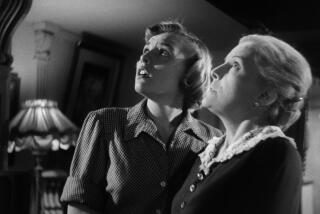Lone Pine: All About Location, Location, Location
LONE PINE, Calif. — “Hi-yo Silver, away!” Those famous words still echo through the canyon where the masked man and his sidekick, Tonto, rode through the nearby Alabama Hills ridding the West of bad guys. The Alabama Hills, in the shadow of lofty Mt. Whitney, have been used since 1920 as a location in hundreds of films--and not just for Westerns.
Films requiring a foreign country’s rocky, desert landscape--think Afghanistan, Pakistan, India, parts of the Middle East, Mexico and South America--have been shot there. Even films depicting lunar landscapes have been shot on location here, just three hours north of the Hollywood studios.
In his book, “On Location in Lone Pine,” author Dave Holland noted that 272 movies had been shot here starring such actors as John Wayne, Roy Rogers, Gene Autry, Mel Gibson, Debbie Reynolds and Jodie Foster, among others. Cops chased Humphrey Bogart up Whitney Portal Road in the 1941 film “High Sierra”; the Alabama Hills stood in for the Andes when John Wayne starred in 1947’s “Tycoon”; Lucille Ball and Desi Arnaz almost slid off Whitney Portal Road in “The Long Long Trailer” (1955). The the list goes on.
Given all this, it’s not surprising that Lone Pine celebrates its movie history with a yearly October festival featuring concerts in the hills, movie location tours and a Sunday parade. The 12th annual festival starts today with activities scheduled throughout the weekend.
Among selections this year will be Tom Mix in 1933’s “Terror Trail”; Ken Maynard in 1934’s “Wheels of Destiny”; the 1936 “Rhythm on the Range,” featuring the song, “I’m an Old Cowhand” sung by Bing Crosby; Cesar Romero in 1939’s “Cisco Kid”; Roy Rogers in 1939’s “Saga of Death Valley”; one of John Wayne’s first movies, the 1936 film “King of the Pecos”; Audie Murphy in 1960’s “Hell Bent for Leather” and “Hopalong Cassidy-Public Hero No. 1,” a 2001 documentary.
Guest stars include this year’s grand marshal of the parade Loren Janes, who was in “How the West Was Won,” Ben Cooper who starred in “The Outcast,” Alex Cord from the 1966 version of “Stagecoach,” Robert Fuller from in the hit series “Laramie,” Herb Jeffries, the first African American movie hero in the ‘30s, and William Wellman Jr., who is the son of William A. Wellman and works as an actor, writer and producer.
“How the West Was Won” will be Saturday night’s featured movie. Narrated by Spencer Tracy, the movie stars Debbie Reynolds, Gregory Peck, James Stewart, John Wayne and Eli Wallach.
Annual attendance at the festival ranges between 4,000 and 5,000 people, said Dorothy Bonnefin, the film festival director.
Most of the films shot in and around Lone Pine were westerns, but commercials and music videos have been shot there as well. Townsfolk were frequently used as some of the hundreds of extras in the films.
The founder of the Lone Pine Film Festival, Kerry Powell, remembers at the age of 6 seeing a temple among the tent city in the Alabama Hills used to portray India, but she was especially captivated by the elephants when they were filming the 1938 production of “Gunga Din.”
Children never expected to see elephants except in the circus, explained Powell, 67, and to see them lumbering across the Alabama Hills was astounding.
Watching westerns being made across the highway from her house at the Anchor Ranch was practically an everyday occurrence for Powell, as was seeing film crews and stars in the town.
“We didn’t pay much attention in the ‘40s, ‘50s and ‘60s, so we took them for granted,” said Powell. “Then we finally realized the history we have here with the film industry.”
Wanting to redecorate their Frontier Motel in a Western motif, she and her husband went to Sunset Boulevard to shop for art work, and while looking at movie posters she realized that the some of the backgrounds had the distinct look of the Alabama Hills. “I got so excited that there were pictures available with our scenery and movie stars in them,” said Powell, “I got the idea for the film festival.”
With Roy Rogers agreeing to dedicate a plaque commemorating the movies made in the Alabama Hills, cooperation from the California Arts Council and the Southern Inyo Artisan Guild, the Lone Pine Film Festival was born in 1990.
Stunt man Janes remembers wearing a dress and tripping on it when he doubled for Debbie Reynolds in “How the West Was Won.” In the movie, Janes said, Reynolds stands up to see what happened to Gregory Peck as he went off the side of a cliff in an Indian chase scene. The wagon hits a bump and Janes, as Reynolds, falls out.
“I did the fall out from the wagon at a dead run with the horses, hit the ground, rolled, got up, tripped on the skirt. I’m not used to skirts like women, so I tripped on it a couple of times when I tried to get up and run. Then they stampeded 1,100 head of wild horses, mules and horses and I had to let them run all around me, and I’m in the middle of this,” said Janes.
Janes, co-founder of the Stuntmen’s Assn. of Motion Pictures and Television, will moderate a Hollywood stunt panel discussion. Other panel members include Diamond Farnsworth, Polly Burson, Roy Clark and Neil Summers.
The talented, athletic Janes, who comes from a family of ranchers, worked on 15 films in the Alabama Hills during his 48-year career and was a stunt double for many actors including Gregory Peck, Clint Eastwood and James Garner. As Steve McQueen’s stunt double for 23 years, Janes’ last film in the hills was McQueen’s 1966 “Nevada Smith.” James said he has compiled more than 500 features and 2,100 TV shows on his filmography as a stuntman, actor, stunt coordinator and second unit director.
Wrangling horses, driving covered wagons, playing good guy, bad guy, shooting and sometimes dying was all in a days work for cowboy extras in the Alabama Hills. In the ‘30s the bonus was getting paid $5 a day. Leroy Cline started working as an extra in 1930 at the age of 17 and continued for 30 years.
Cline was one of 17 wranglers hired by Russ Spainhower. To save money the Monogram studio used two sets of horses, Cline said. Dressed in black on black horses, they road down the road as the bad guys. At the end of the road they changed into white clothes and jumped onto white horses, turned around and the crew filmed them chasing the bad guys.
Hollywood gave the pubic an early vision of Afghanistan, Pakistan and India in Tyrone Power’s 1953 film “King of the Khyber Rifles.” Bonnefin played a British lady extra sitting on a veranda sipping lemonade. The label inside the dress she wore had Maureen O’Hara’s name on it, said Bonnefin.
One of her favorite festival stories is about the two guys who came from Rio de Janeiro about eight years ago. Told that Lone Pine was near L.A., they flew into L.A., jumped into a cab and $300 later arrived in Lone Pine. The townspeople found transportation for them back to the airport.
To preserve the filmmaking history in and around Lone Pine, business leaders and local movie fans have purchased land to build a permanent film history museum, said Bonnefin. “There is a lot to be proud of here, I’m really excited about the museum,” said Powell.
“Movie fan translates to movie historian if you’re serious about your passion,” Holland says in the video version of his book. He conducts tours of the movie settings. “For a long time they called Hollywood the dream factory, the place where dreams are manufactured and if that’s so, and it certainly is up here in the Alabama Hills, a lot of those dreams came true when Hollywood came on location in Lone Pine.”
*
The 12th Lone Pine Film Festival will celebrate more than 80 years of movie-making Oct. 5-7 in Lone Pine, Calif., three hours north of Los Angeles. Guests expected to attend include Loren Janes, Robert Fuller, Connie Stevens, Ben Burtt, Alex Cord, Herb Jeffries, Peggy Stewart, Ruth Terry, William Wellman, Jr. and Paramount producer, A.C. Lyles. The schedule calls for tours of film sites, a stunt panel, showing of eight movies in addition to “How the West Was Won.” Ticket information: ( 760) 876-9103.
More to Read
Only good movies
Get the Indie Focus newsletter, Mark Olsen's weekly guide to the world of cinema.
You may occasionally receive promotional content from the Los Angeles Times.










